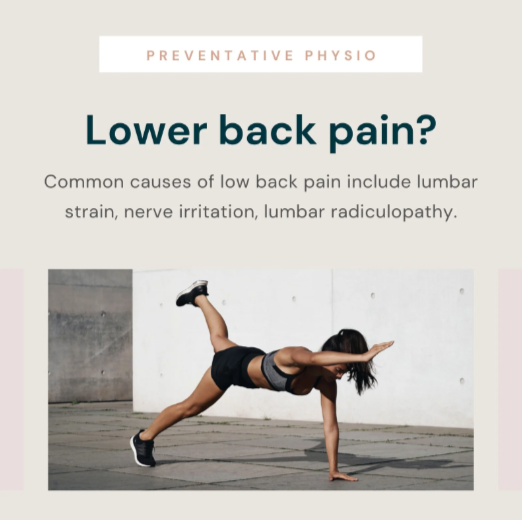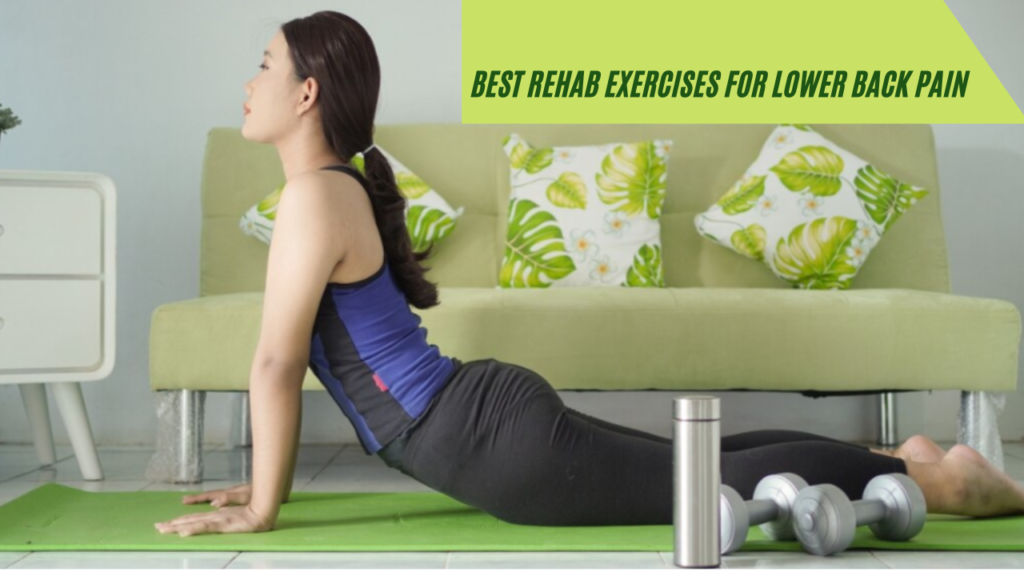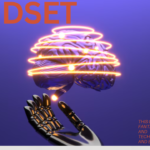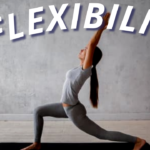This condition is common with people of different ages and origins and affects many individuals causing lower back pain. Lower back pain may be caused by an accident, poor posture, or various chronic diseases that seriously affect a person’s quality of life due to constant pain. Physical activities for rehabilitation are vital to decrease pain and promote the process of recovery. In this article, you will find the complete guide on how to get comfort and increase the strength of the lower back and identify the most effective exercises that can be used to treat lower back pain.
What is Lower Back Pain?
There are millions of people worldwide in pain, located in the area of the lower back. Some causes can be related to poor posture, muscle pulls, herniated discs, degenerative diseases like arthritis, and others. Indeed, knowledge will be a great tool to help you cure the pain in your lower limbs.
One of the major treatments that relieves lower back pain is rehab exercises for lower back pain, which control the pain and relieve it. These exercises will also be used for long-term treatment for total recovery, preventing possible future injuries.
Exercise form one of the central parts in the rehabilitation of the musculature involved in spine bracing, improvement in flexibility of the musculature, and achievement of reduction of pain. Rehab Exercises for Lower Back Pain help to strengthen the musculature engaged in stabilization, amplification of movement, and improvement of the condition of the spine. Proper and regular practice can have a long-term improvement in pain and function.
Core Strengthening
Good core strength supports a healthy back. The core muscles generally involve the abdominal wall, obliques, and muscles of the lower back that all act simultaneously to support the spine. Strengthening the core reduces the burden on the lower back.
Improved Flexibility
Flexibility exercises are more critical for maintaining a healthy range of motion in the spine and the surrounding muscles. These muscles, especially when tightened, tend to pull at the lower back, causing a great amount of pain and restlessness. Bunched-up tension in your muscles can be spruced up by stretching exercises to reap better movement and reduced pain.
Reducing Pain
Rehabilitation exercises help relieve pain by allowing one to locate and treat the cause of discomfort. Strengthening weakened muscles, enhancing flexibility, and good spinal health greatly reduce pain. Exercise aids in releasing endorphins, which are the natural painkillers of the body. Endorphins released during routine may help manage lower back pain.
Best Rehab Exercises for Lower Back Pain

Pelvic Tilts
Pelvic tilts offer, occasionally, a mild introduction to developing strength within the lower back. It is chiefly the lower back and core muscles that instigate stability and strength.
How to Do It
Rest on your back with knees bent, and soles flat on the floor.
Tighten abdominal muscles by pressing the small of your back into the floor.
After a few while, hold the pose and then let go.
Do this for 10-15 reps.
Tilting of the pelvis is the initial move that activates the core, which is very crucial in stabilizing the spine and advocating for relief from lower back pain.
Cat-Cow Stretch
Cat-Cow stretches are a way of relaxing the spine so that flexibility may be enhanced and also tension released in the small muscles bundled along the midline. Mobilization of the spine and muscles of the back is also stretched in the process.
How to Do It
Come onto your hands and knees in a tabletop position.
Inhale arch your back, and lift your head and tailbone towards the ceiling (Cow).
Exhale, around the spine, tucking the chin to the chest).
Next, continue the stretch for 1-2 minutes, flowing from one shape to another.
The Cat-Cow Stretch increases the mobility of the spine; it’s useful in relieving low back stiffness.
Bridges
Bridges are simply wonderful exercises for the glutes and the lower back. This is an excellent move for developing tone and strength in the muscle groups that support the spine.
How to Do It
Lie straight on the ground with your knees straight up and feet flat on the floor
Bridging: Lift your hip upward while you squeeze your glutes.
Hold it for a few seconds and then slowly let your hips down
Repeat for 10-15 reps.
The other benefit of doing bridges is that it activates the glutes in conjunction with the lower back muscles. This will ensure better support of the spine and, at the same time, take away lower back pain.
Bird-Dog Exercise
The Bird-Dog exercise is an ideal exercise to create stability and balance, in core, and lower back muscles. This exercise develops better coordination and support of the spine.
How to Do It
You have to get in the above position as if you’re doing a mountain climbing exercise. Place your hands in line with your shoulders, and your knees in line with your hip.
Stretch your right arm forward and left leg backward. Maintain a neutral spine.
Holding on to that position, alternately the arms forward and backward.
Try and do nearly 10-12 repetitions towards the right side, then towards the left side.
The bird-dog exercise increases the core stability and balance, which in turn reduces the load on your lower back.
Child’s Pose
It is done in such a position that the muscles in the lower back get stretched, which elongates the muscle, relieving tension from parts of the back. The child’s pose relaxes the individual also and mostly relieves the pain in the lower back.
What to Do It
Kneel on the floor then sit back on your heels.
Extend your arms forward, sitting on the floor, and lay your head in front of you.
Breathe deeply, and then hold for 1–2 minutes.
This one is excellent for calming the lower back muscles and may even decrease pain simultaneously.
Knee-to-Chest Stretch
This stretch helps to lengthen the lower back and take pressure off of it. It increases flexibility in the lower back and decreases stiffness.
How to Do It
Lay on your back with knees bent and feet placed flat on the floor.
Pull up one knee to the chest while holding the body behind the thigh with both hands.
Stay in this stretch for 20-30 seconds, then stretch the other leg.
Repeat this on each leg 2-3 times.
The Knee-to-Chest stretch releases stress from the lower back muscles, improves flexibility, and reduces pain.
Seated Forward Bend
This stretch releases the hamstrings and provides the lower back muscles with a stress-free environment to become flexible, hence ensuring flexibility in the lower back. This stretch is good in improving flexibility, hence increasing the range of motion of the lower back.
How to Do It
Sit on the floor and stretch out the legs in front.
At the hips, bend forward to reach towards your loos while maintaining your back straight.
Hold for 20 – 30 seconds, release.
Repeat 2-3 times.
The Seated Forward Bend stretches the old lower back and leg muscles to relieve pain and improve flexibility.
More Healthy Posture Tips and Further Lower Back Pain Support Ideas
Proper alignment will also contribute to avoiding and easing back pain. The job surface you have should be ergonomically designed to fit you and should not require you to bend forward or sit in any position without moving for lengthy periods. Make sure your lower back is well supported while sitting in your chair and, when sitting or standing, keep your feet flat on the floor.
Be physically fit to maintain a healthy back. Low-impact physical fitness activities like walking, swimming, or riding a bike can be easily included in one’s routine. If a person is more active physically, he has muscles stronger and more flexible and thus less likelihood of getting lower back pain.
Another treatment helpful to relieve spasms, is the application of heat, which can be used by application alternating with treatments that use cold compression, both for inflammatory reduction and numbing of the pain, make sure to switch between treatments with heat with cold, for heat treatment, you can use a heating pad or warm towel, while for cold treatment, an ice pack or cold compress.
Relaxation Techniques and Mindfulness
Stress and tension can result in lower backache. One should develop mindfulness and practice relaxation, either through deep breathing, meditation, or yoga, to reduce the amount of stress and learn the art of relaxation. These strains are relieved, through these techniques, from the muscles, so that relief from the pain is obtained.
Consult a Physical Therapist
In most cases of chronic lower back pains, it is prudent to seek the help of a physical therapist. He or she acts as an exercise prescription in developing exercises tailor-made for you that are relevant to your condition. In addition, they will ensure your safety and that the exercises are done with proper form and techniques to promote efficiency.
A lower backache can be such a push-off, but doing proper rehab exercises can be so relieving. Here is one of the exercises you should always have in your training log. This will help you to make your lower back more tight, to make your flexibility better, and, most importantly, it will improve your general condition.
The rule here is simply consistency. Use professional support to optimize the recovery process. There are several ‘must-have’ things to help you keep your lower back pain under control and to prevent it from coming back: proper posture, good physical activity which includes rehab exercises for lower back pain, and relaxing or visualization or other techniques.
In Summary
Rehab exercises for lower back pain should be achieved through good posture, regular exercise, and rehabilitation exercises when necessary. These are all consistent with professional advice, done consistently to yield relief — most of the time — from such pain and prevent any sort of injury in the future. Prioritize your lower back health for an overall enhancement of your well-being.



